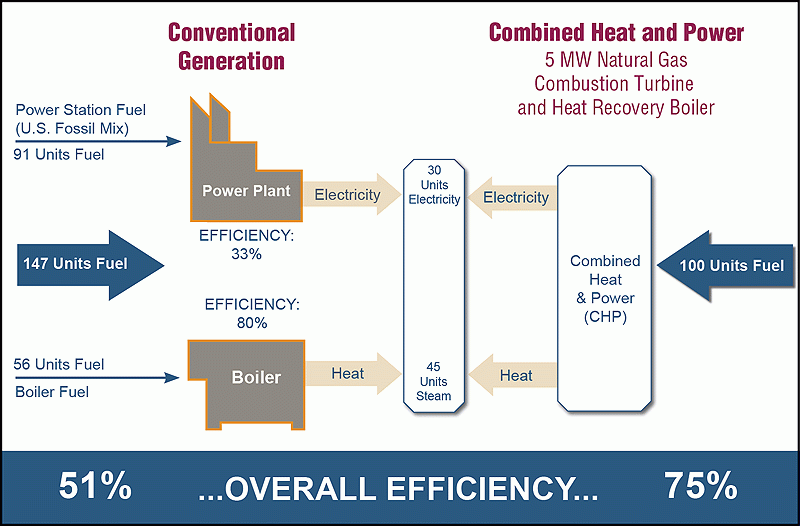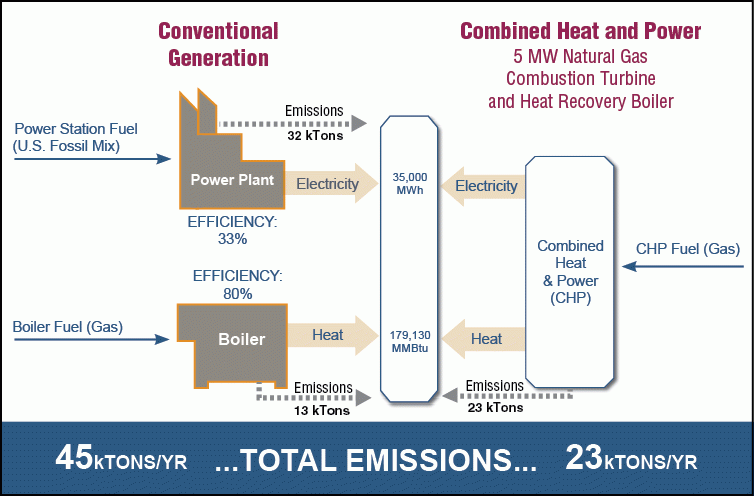CHP Benefits
CHP offers a number of benefits compared to conventional electricity and thermal energy production, including:
Efficiency Benefits
CHP requires less fuel to produce a given energy output and avoids transmission and distribution losses that occur when electricity travels over power lines.
Environmental Benefits
Because less fuel is burned to produce each unit of energy output and because transmission and distribution losses are avoided, CHP reduces emissions of greenhouse gases and other air pollutants.
Economic Benefits
CHP can save facilities considerable money on their energy bills due to its high efficiency, and it can provide a hedge against electricity cost increases.
Reliability Benefits
Unreliable electricity service represents a quantifiable business, safety, and health risk for some companies and organizations. CHP is an on-site generation resource and can be designed to support continued operations in the event of a disaster or grid disruption by continuing to provide reliable electricity.
Learn more about these benefits:
Efficiency Benefits
The average efficiency of fossil-fueled power plants in the United States is 33 percent. This means that two-thirds of the energy used to produce electricity at most power plants in the United States is wasted in the form of heat discharged to the atmosphere.
By recovering this wasted heat, CHP systems typically achieve total system efficiencies of 60 to 80 percent for producing electricity and useful thermal energy. Some systems achieve efficiencies approaching 90 percent.
The illustration below demonstrates the efficiency gains of a 5 megawatt (MW) natural gas-fired combustion turbine CHP system compared to conventional production of electricity and useful thermal energy (i.e., purchased grid electricity and thermal energy from an on-site boiler).
Conventional Generation vs. CHP: Overall Efficiency
 This is an example of a typical CHP system. To produce 75 units of electricity and useful thermal energy, the conventional system uses 147 units of energy inputs-91 for electricity production and 56 to produce useful thermal energy-resulting in an overall efficiency of 51 percent. However, the CHP system needs only 100 units of energy inputs to produce the 75 units of electricity and useful thermal energy, resulting in a total system efficiency of 75 percent.
This is an example of a typical CHP system. To produce 75 units of electricity and useful thermal energy, the conventional system uses 147 units of energy inputs-91 for electricity production and 56 to produce useful thermal energy-resulting in an overall efficiency of 51 percent. However, the CHP system needs only 100 units of energy inputs to produce the 75 units of electricity and useful thermal energy, resulting in a total system efficiency of 75 percent.
A CHP system's efficiency depends on the technology used and the system design. The five most commonly installed CHP power sources (known as "prime movers") offer these efficiencies:
- Steam turbine: 80 percent
- Reciprocating engine: 75-80 percent
- Combustion turbine: 65-70 percent
- Microturbine: 60-70 percent
- Fuel cell: 55-80 percent
The Catalog of CHP Technologies contains detailed information about these technologies.
Avoided Transmission and Distribution Losses
By producing electricity onsite, CHP also avoids transmission and distribution (T&D) losses that occur when electricity travels over power lines. Within the five major power grids in the United States, average T&D losses vary from 5.82 percent to 7.38 percent, with a national average of 6.18 percent (Source: Emissions & Generation Resource Integrated Database [eGRID]). Losses can be even higher when the grid is strained and temperatures are high. By avoiding T&D losses associated with conventional electricity supply, CHP further reduces fuel use, helps avoid the need for new T&D infrastructure, and eases grid congestion when demand for electricity is high.
Environmental Benefits
CHP systems offer considerable environmental benefits when compared with purchased electricity and thermal energy produced on site. By capturing and utilizing heat that would otherwise be wasted from the production of electricity, CHP systems require less fuel to produce the same amount of energy.
Because less fuel is combusted, greenhouse gas emissions, such as carbon dioxide (CO2), as well as other air pollutants like nitrogen oxides (NOx) and sulfur dioxide (SO2), are reduced.
The following diagram shows the magnitude of reduced CO2 emissions of a 5 megawatt (MW) natural gas-fired CHP system compared to the same energy output from conventional sources.
Conventional Generation vs. CHP: CO2 Emissions
 This diagram illustrates the CO2 emissions output from electricity and useful thermal energy generation for two systems: (1) a fossil fuel-fired power plant and a natural gas-fired boiler; and (2) a 5 megawatt combustion-turbine CHP system powered by natural gas. The separate heat and power system emits a total of 45 kilotons of CO2 per year (13 kilotons from the boiler and 32 kilotons from the power plant), while the CHP system, with its higher efficiency, emits 23 kilotons of CO2 per year.
This diagram illustrates the CO2 emissions output from electricity and useful thermal energy generation for two systems: (1) a fossil fuel-fired power plant and a natural gas-fired boiler; and (2) a 5 megawatt combustion-turbine CHP system powered by natural gas. The separate heat and power system emits a total of 45 kilotons of CO2 per year (13 kilotons from the boiler and 32 kilotons from the power plant), while the CHP system, with its higher efficiency, emits 23 kilotons of CO2 per year.
Economic Benefits
CHP can offer a variety of economic benefits, including:
- Reduced energy costs: CHP reduces energy bills because of its high efficiency. By using waste heat recovery technology to capture wasted heat associated with electricity production, CHP systems typically achieve total system efficiencies of 60 to 80 percent, compared to 50 percent for conventional technologies (i.e., purchased utility electricity and an on-site boiler). Basically less fuel is needed for a given unit of energy output. Also, because CHP systems typically use natural gas which is often cheaper than purchased electricity, CHP can help reduce electricity bills. Bills are further reduced because the CHP output reduces electricity purchases.
- Avoided capital costs: CHP can often reduce the cost of replacing heating equipment.
- Protection of revenue streams: Through onsite generation and improved reliability, CHP can allow facilities to continue operating in the event of a disaster or an interruption of grid-supplied electricity.
- Less exposure to electricity rate increases: Because less electricity is purchased from the grid, facilities have less exposure to rate increases. In addition, a CHP system can be configured to operate on a variety of fuel types, such as natural gas, biogas, coal, and biomass; therefore, a facility could build in fuel switching capabilities to hedge against high fuel prices.
Analyzing Economic Feasibility
The economic benefits of any CHP project are dependent on electricity rates, system design, equipment cost and CHP operating practices. The value of the benefits will depend on the needs and goals of the investor. A feasibility analysis is conducted to determine the technical and economic viability of a project.
- Use our questionnaire as a preliminary assessment of whether your facility might be a good candidate for CHP.
- Visit the Project Development section of this Web site to learn about the steps required to consider and install a CHP system.
- Find financial incentives for CHP projects in dCHPP (CHP Policies and incentives database).
Reliability Benefits
In addition to reducing operating costs, CHP systems can be designed to continue operating in the event of grid outages to supply continuous power for critical functions.
Interruptions of grid-supplied electricity service represents a quantifiable business, safety, and health risk for some facilities.
- The first step in incorporating CHP into a strategy to reduce business risk is to calculate the value of reliability and risk of outages for a specific facility.
- After identifying and quantifying (in monetary terms) the value of reliable power to facility operations, the costs of designing and configuring CHP technology for outage protection can be estimated and evaluated. CHP systems can be configured to meet the specific reliability needs and risk profiles of any facility.
Valuing the Reliability of Combined Heat and Power provides methods to estimate the value of CHP as electricity supply reliability measure and the merits of different design strategies.
